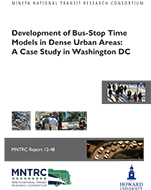Abstract:
Bus transit reliability depends on several factors including the route of travel, traffic conditions, time of day, and conditions at the bus stops along the route. The number of passengers alighting or boarding, fare payment method, dwell time (DT), and the location of the bus stop also affect the overall reliability of bus transit service. This study defines a new variable, Total Bus Stop Time (TBST) which includes DT and the time it takes a bus to safely maneuver into a bus stop and the re-entering the main traffic stream. It is thought that, if the TBST is minimized at bus stops, the overall reliability of bus transit along routes could be improved.
This study focused on developing a TBST model for bus stops located near intersections and at mid-blocks using ordinary least squares method based on data collection at 60 bus stops, 30 of which were near intersections while the remaining were at mid-blocks in Washington DC. The field data collection was conducted during the morning, mid-day, and evening peak hours. The following variables were observed at each bus stop: bus stop type, number of passengers alighting or boarding, DT, TBST, number of lanes on approach to the bus stop, presence of parking, and bus pad length. The data was analyzed and all statistical inferences were conducted based on 95% confidence interval. The results show that the TBST could be used to aid in improving planning and scheduling of transit bus systems in an urban area.
Publications:
Authors:
STEPHEN ARHIN, PH.D., P.E., PTOE, PMP
Dr. Arhin is an assistant professor of the Department of Civil and Environmental Engineering of Howard University, the director of the Howard University Transportation Research and Traffic Safety Data Center (HUTRC), and the associate director of the transit research conducted by Howard University under the Mineta National Transit Research Consortium. His experience spans more than 19 years in all facets of transportation and traffic safety engineering, including traffic safety and operations, research, planning, transit operations and ITS. He has extensive experience working with state and local transportation agencies on a wide variety of safety, operations, and design projects. Prior to his tenure at HUTRC, he was a senior traffic engineer with a number of nationally recognized engineering consulting firms. Dr. Arhin has authored and co-authored several project reports, published articles in peer-reviewed journals and presented at conferences on such topics as countdown pedestrian traffic signals, intelligent transportation technologies, pavement condition monitoring, crash data analysis, traffic volume trends, mitigation of reflective cracking in composite highway pavements, truck weight enforcement, and red-light violation index. He is a member of ITE, TRB and ASCE and serves as a peer reviewer for several journals. He is a registered project management professional (PMP).
ERROL NOEL, PH.D., P.E.
Dr. Noel is a tenured full professor of the Department of Civil and Environmental Engineering of Howard University. He chaired the Department from 2000-2010 and has served as executive director of the Howard University Traffic Safety and Transportation Data Center and as director for transit research conducted by Howard University under the Mineta National Transit Research Consortium. He teaches graduate and undergraduate courses in traffic and highway engineering, project management, and engineering systems analysis. His research has focused on applied research for solving urban transportation problems. In parallel with his responsibilities at Howard University, he has more than forty years of professional engineering experience, particularly in the field of highway engineering, traffic engineering, and transportation research. He is a member of ITE, ASCE, TRB, and ASEE, and has a distinguished record of published articles. Since 1998 his research has involved urban transit operation and safety, management of snow removal using intelligent transportation technologies, pavement ride quality and condition monitoring, traffic-induced vibration, innovations in countdown traffic signals, mitigation of reflective cracking in composite highway pavements, policy on truck weight enforcement, red-light violation index, and standards for red traffic signal installation.


